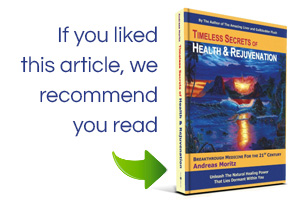By Andreas Moritz
The main purpose of Abyanga or oil massage as part of the Ayurvedic daily routine is to assist in preventing the accumulation of physiological toxins (AMA) and to lubricate and promote flexibility of the muscles, tissues and joints. Once applied to the skin, the oil passes quickly through the various layers of the skin and the underlying connective and fat tissues. The oil combines with any toxins present there, especially those that are fat-soluble. Within several minutes of massaging the skin, the oil becomes expelled through the skin along with the toxins.
The classical texts of Ayurveda indicate that daily oil massage promotes softness and luster of the skin, as well as youthfulness. The skin is a major producer of endocrine hormones and is connected to every part of the body through thousands of cutaneous nerves. Daily oil massage can, therefore, balance the two master systems of the body – the nervous system and the endocrine system. The following are directions to assist you in learning the Ayurvedic daily do-it-yourself oil massage.
- Unless specific oil has been recommended for you, cold-pressed (also called expeller-pressed) and unrefined sesame oil (not roasted sesame oil) should be the preference. Although sesame oil is suitable for all body types (for external use), if you find it irritating to the skin, you may try olive oil or coconut oil as an alternative. To purify the massage oil, ‘cure’ it by heating it to about 100 degrees Celsius, the boiling point of water. Add a drop of water to the oil at the beginning, and when the water begins to splutter, you will know that the proper temperature has been reached. You may prepare the entire contents of the bottle at once or do so as needed.
- Before beginning the massage, the oil should be at or slightly above body temperature, especially during the wintertime. Start by massaging the head, if you intend to shampoo afterward. Place a small amount of oil on the fingertips and palms, and begin to massage the scalp vigorously. Since the head and feet are considered the most important parts to be emphasized during Abyanga, spend proportionally more time on the head and feet than on other body parts.
- After massaging the head, gently apply oil with your hands to your face and the outer parts of your ears.
- Massage both the front and back of the neck, and the upper part of the spine.
- You may want to apply a small amount of oil to your entire body and then continue with the massage in each area.
- Next massage your arms. The proper motion is back and forth over the long bones and with a circular motion over the joints. Also massage your hands and fingers.
- Now apply oil to the chest and abdomen. A very gentle circular motion should be used over your heart. Repeat this circular motion, following the ‘bowel pattern’ from the right lower part of the abdomen, moving clockwise toward the left lower part of the abdomen.
- Massage the back and spine. Some areas are more difficult to reach, so you may want to ask your partner to help you.
- Massage the legs. Like the arms, use a back and forth motion over the long bones and a circular motion over the joints.
- Lastly, massage the soles of the feet. Since all body reflex points are situated in the feet, a good amount of time should be spent on massaging the feet.
Ideally, one should spend about 5-10 minutes on the massage, possibly every morning. If there is not enough time for a full body massage, then a mini-massage of 1-2 minutes on the head and feet is preferable. After your massage, take a warm shower or bath. Use soap only on the genital area and under the arms. This will leave a thin film of oil on the skin that is very beneficial for toning the skin and keeping the body muscles warm throughout the day. If, however, you have applied too much oil, a mild soap made from natural ingredients can be used to wash it off. Sesame oil in particular has a disinfecting action, which helps to ward off harmful microbes.
——————————
You may share or republish this article provided you clearly mention the name of Andreas Moritz and paste a hyper link back to the web page

